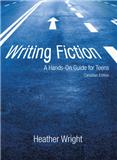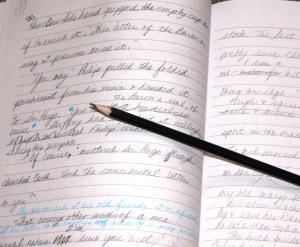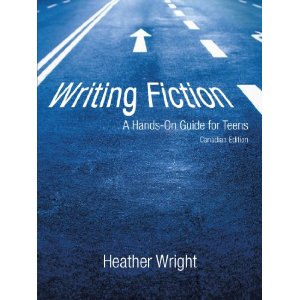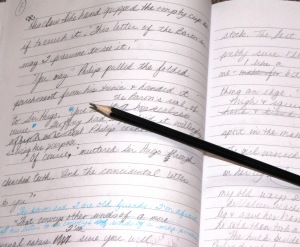I had to take a dose of my own medicine yesterday. My editor e-mailed a deadline to me and I was unprepared. So I did what I advise all writers to do—I started brainstorming. I made a list of all the things I like to write about and another of what I like to read about and I still felt like my own creative well was empty.
Is this writers’ block? laziness? stubbornness? Whatever it was, it felt lousy and I knew I had to get over it. Get over myself wishing I didn’t have to do it. Get over wanting to run away from my responsibilities. You get the picture. So, I did what I’ve told other writers to do, just started the thing.
And groaned about how difficult it is to face the blank screen—and to resist walking away and boiling the kettle for another cup of tea.
I made the tea.
Then I did the next best thing to writing; I hit the books and the Internet to research what other writers do when they’re in the same, gloomy, non-writing place. Clearly I am not alone. Google presented me with 2,710,000 sites for my search: “overcoming writer’s block.” Nearly three million people writing about writer’s block? Now I’m getting researcher’s block!
I did find a couple of gems, though.
Franz Kafka (“Metamorphosis”) said: “You do not need to leave your room. Remain sitting at your table and listen. Do not even listen, simply wait, be quite still and solitary. The world will freely offer itself to you to be unmasked, it has no choice, it will roll in ecstasy at your feet.” Well, it was clear to me after giving this a try, that the only “world” I was freely offered was one with a list of chores and “must remember to buy cereal on the way home from work.” The only things rolling at my feet were dust bunnies. And, they’re more the static rather than the ecstatic variety as they attached themselves to my slippers and followed me to the kitchen. More tea.
Richard Condon wrote: “When I feel dried up I deal myself a few games of solitaire at my desk. I’ve been doing it all my life. Sometimes I play 10 or 20 games, sometimes 40. Once, I played for three straight days. The important thing is not to leave the workplace.” Sadly, I have no problem doing this; in fact, I always delete my Free Cell statistics after 100 games so I won’t be ashamed of the total number of games that I have played. Along with checking my e-mail, tidying my files, and deleting old messages, I have found many ways not to leave my “workplace”—and not write.
Other advice on writer’s block? Here’s one from Quentin Crisp: “Ignore it: you never stop speaking; why stop writing?” My answer to him is: “because I don’t feel like it.”
“And why don’t you feel like it?” I hear him ask me and it ticks me off and then—I realize what the answer is in an embarrassing flash of insight.
I’m afraid.
Yup. I don’t want to write because I don’t want to fail. What if this is the article that my editor said was just too awful to print. And if I can’t write this article, can I ever write anything else? Needless to say, all the advice I’ve written to others about not listening to their critical voices and, about following the advice of Anne Lamott and giving themselves permission to write the “shitty first draft”* went right out the window. The blank screen wasn’t just blank; it was the enemy.
So, I switched the thing off.
And picked up a pencil and some paper–because quitting really wasn’t an option.
That simple action made all the difference. Writing with paper and pencil was the first method I had used to create as a child and as a student, and by some magic, the connections were still there. I doodled and scribbled, added bits in margins or between lines, changed pen colours and made little flowers around the holes at the side of the paper. I don’t always write in order, so it was freeing to draw sweeping arrows from a bit I’d written at the top of the page to the bottom where I’d suddenly thought of more to add. Turning the pages, numbering them, scribbling diagonally across the empty backs of pages with new ideas, filling those pages was hugely satisfying. Writing became a visceral act; I felt totally involved and energized. And amazingly disconnected from the critic.
Because I was writing on paper, I had permission to be messy, cluttered, tangential, and free. The screen demands order and clean copy. I mean, just look at the thing! Everything ‘looks’ perfect—even lousy writing—and how depressing is that!
Have I found the universal cure for getting past the barrier to creativity? No. But I found one that works for me. Thank heavens for deadlines
—and pencils and paper.
Bird by Bird: Some Instructions on Writing and Life. Anne Lamott, First Anchor Books Edition, 1995
Originally printed in What If? Canada’s Magazine for Creative Teens
Like this:
Like Loading...
 This afternoon marks another step in the marketing plan that is essential for sales as a self-published author. I’ve had fun creating brochures and book marks and material to hand out on the day and part of me is looking forward to the sales experience. Another part of me is very anxious and wishing I were just at Eden Mills to enjoy the event. I’ll miss attending the readings, but I’m counting on my son to bring back regular reports–and requests to buy books–throughout the afternoon. Though this Sunday will be a change from our normal routine, I will, as always, be very happy to have his company. That will never change.
This afternoon marks another step in the marketing plan that is essential for sales as a self-published author. I’ve had fun creating brochures and book marks and material to hand out on the day and part of me is looking forward to the sales experience. Another part of me is very anxious and wishing I were just at Eden Mills to enjoy the event. I’ll miss attending the readings, but I’m counting on my son to bring back regular reports–and requests to buy books–throughout the afternoon. Though this Sunday will be a change from our normal routine, I will, as always, be very happy to have his company. That will never change.




